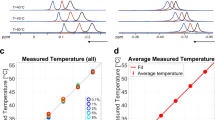Abstract
In this paper, we present the first description of a technique to visualize and quantitate radiofrequency (RF) heating of a tissue phantom during a magnetic resonance imaging (MRI) procedure. We evaluated the heating patterns of four 10 cm diameter transmit/receive surface coils with differing degrees of distributed capacitance. The tissue phantom was a 6% agarose gel doped with 40 mM Na4HTm[DOTP], and possesses a conductivity intermediate to human muscle and fat. Heating was discerned via phase difference mapping using the large temperature dependent chemical shift coefficient for23Na in Na4HTm[DOTP]. This coefficient is −0.5 ppmoC. Heating was highest where the phantom was closest to the surface coils, dropping off towards the center of the coil. No significant difference was observed in the heating patterns between the different surface coils. For the experimental setups used in this study, electric field ‘hot spots’ at the areas corresponding to the placement of the capacitor gaps were not observed.
Similar content being viewed by others
References
US Food and Drug Administration. Magnetic Resonance Diagnostic Device: panel recommendation and report on petitions for MR reclassification. Federal Register 1988;53:7575–7579.
Jin JM, Chen J. On the SAR and field inhomogeneity of birdcage coils loaded with the human head. Magn Reson Med 1997;38:953–63.
Collins CM, Li SZ, Smith MB. SAR and B1 field distributions in a heterogeneous human head model within a birdcage coil. Magn Reson Med 1998;40:847–56.
Jin J. Electromagnetics in magnetic resonance imaging. IEEE Trans Ant Prop 1998;40:7–22.
Chen J, Feng ZM, Jin JM. Numerical simulation of SAR and B1 field inhomogeneity of shielded RF coils loaded with the human head. IEEE Trans Biomed Eng 1998;45:650–9.
Chen CN, Hoult DI. The visualization of RF probe electric fields. Magn Reson Med 1993;29:386–90.
Duvvuri U, Kaufman JH, Patel SD, Bolinger L, Kneeland JB, Leigh JS, Reddy R. Sodium multiple quantum spectroscopy of articular cartilage: effects of mechanical compression. Magn Reson Med 1998;40:370–5.
Gabriel S, Lau RW, Gabriel C. The dielectric properties of biological tissue: II. Measurements in the frequency range 10 Hz to 20 GHz. Phys Med Biol 1996;41:2251–69.
Kato H, Hiraoka M, Ishida T. An agar phantom for hyperthermia. Med Phys 1986;13:396–8.
Shapiro ES, Borthakur A, Bansal N, Leigh JS, Reddy R. Temperature dependent chemical shift and relaxation times of23Na in Na4HTm[DOTP]. J Magn Res 2000;143:213–6.
MacFall JR, Prescott DM, Charles HC, Samulski TV. H-1 MRI phase thermometry in vivo in canine brain, muscle, and tumor tissue. Med Phys 1996;23:1775–82.
Jackson JD. Classical Electrodynamics. New York: Wiley, 1999.
Bruch MD. NMR Spectroscopic Techniques. New York: Marcel Dekker, 1996.
Hoult DI, Chen C-N. The visualization of probe electric fields reveals intense Hot Spots. Proceedings of the Seventh Annual Meeting of the Society for Magnetic Resonance in Medicine. San Francisco, CA, 1988, p. 872.
Chung AH, Hynynen K, Colucci V, Cline HE, Gudbjartsson H, Jolesz F. Optimization of TE for phase temperature mapping in focused ultrasound surgery: in vivo results in rabbit muscle and kidney. Proceedings of the Society of Magnetic Resonance Third Scientific Meeting and Exhibition. Nice, France, 1995, p. 1178.
Cline HE, Hynynen K, Schneider E, Hardy CJ, Maier SE, Watkins RD, Jolesz FA. Simultaneous magnetic resonance phase and magnitude temperature maps in muscle. Magn Reson Med 1996;35:309–15.
Bertsch F, Mattner J, Stehling MK, Muller-Lisse U, Peller M, Loeffler R, Weber J, Messmer K, Wilmanns W, Issels R, Reiser M. Non-invasive temperature mapping using MRI: comparison of two methods based on chemical shift and T1 relaxation. Magn Reson Imaging 1998;16:393–403.
Carter DL, MacFall JR, Clegg ST, Wan X, Prescott DM, Charles HC, Samulski TV. Magnetic resonance thermometry during hyperthermia for human high-grade sarcoma. Int J Radiat Oncol Biol Phys 1998;40:815–22.
Zuo CS, Bowers JL, Metz KR, Nosaka T, Sherry AD, Clouse ME. TmDOTP5−: a substance for NMR temperature measurements in vivo. Magn Reson Med 1996;36:955–9.
Zuo CS, Metz KR, Sun Y, Sherry AD. NMR temperature measurements using a paramagnetic lanthanide complex. J Magn Reson 1998;133:53–60.
Author information
Authors and Affiliations
Corresponding author
Rights and permissions
About this article
Cite this article
Shapiro, E.M., Borthakur, A. & Reddy, R. MR imaging of RF heating using a paramagnetic doped agarose phantom. MAGMA 10, 114–121 (2000). https://doi.org/10.1007/BF02601846
Received:
Revised:
Accepted:
Issue Date:
DOI: https://doi.org/10.1007/BF02601846




